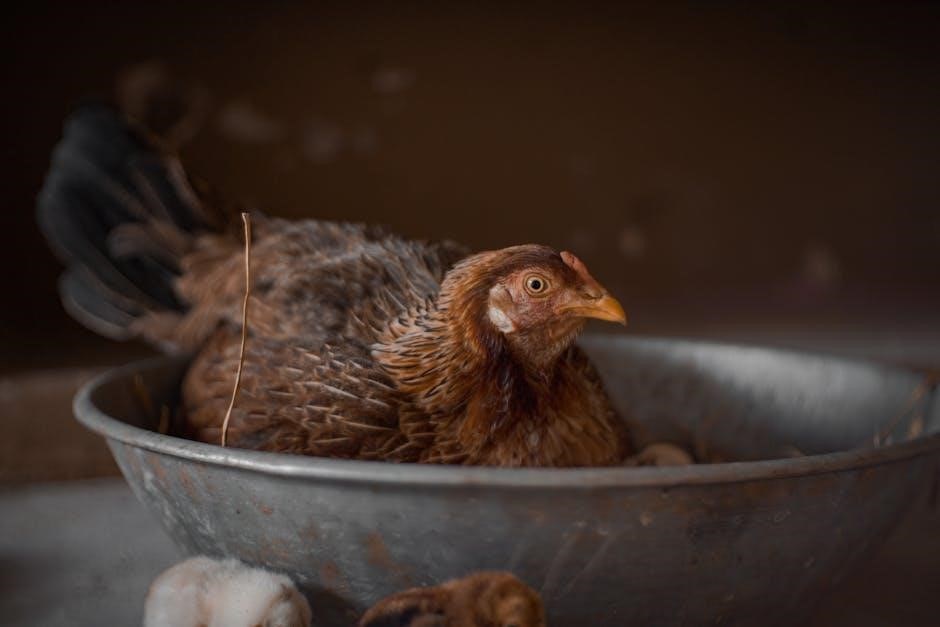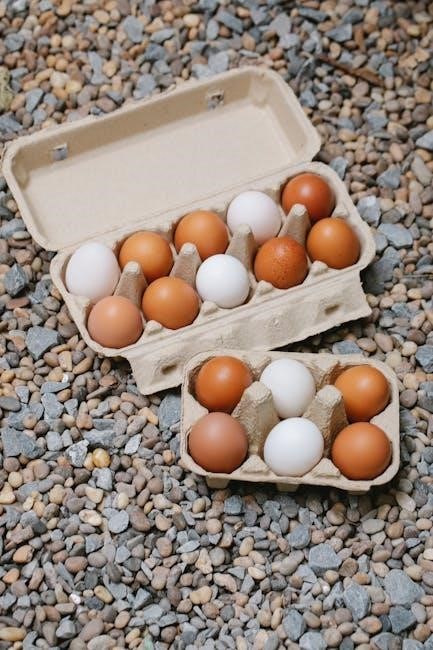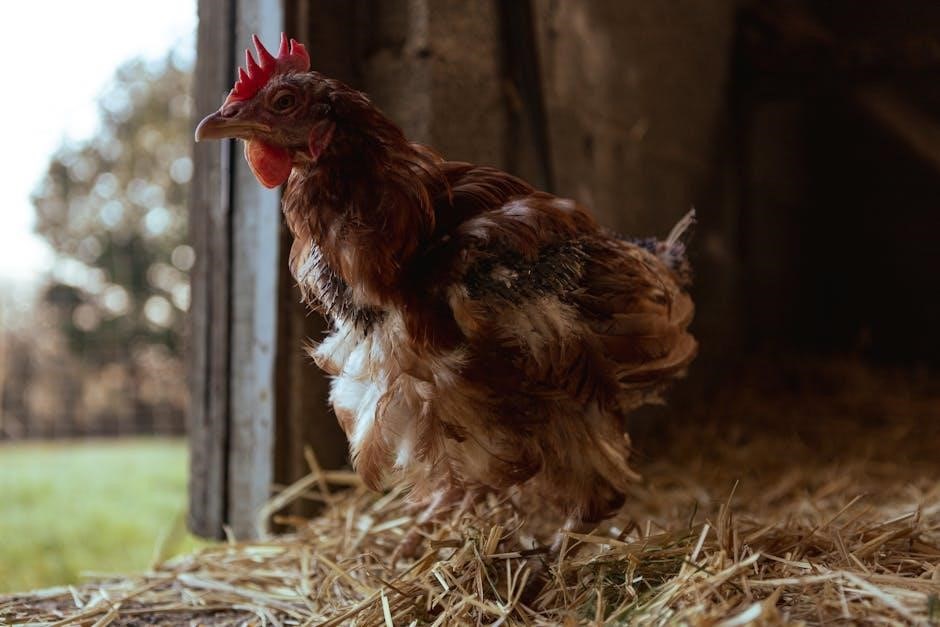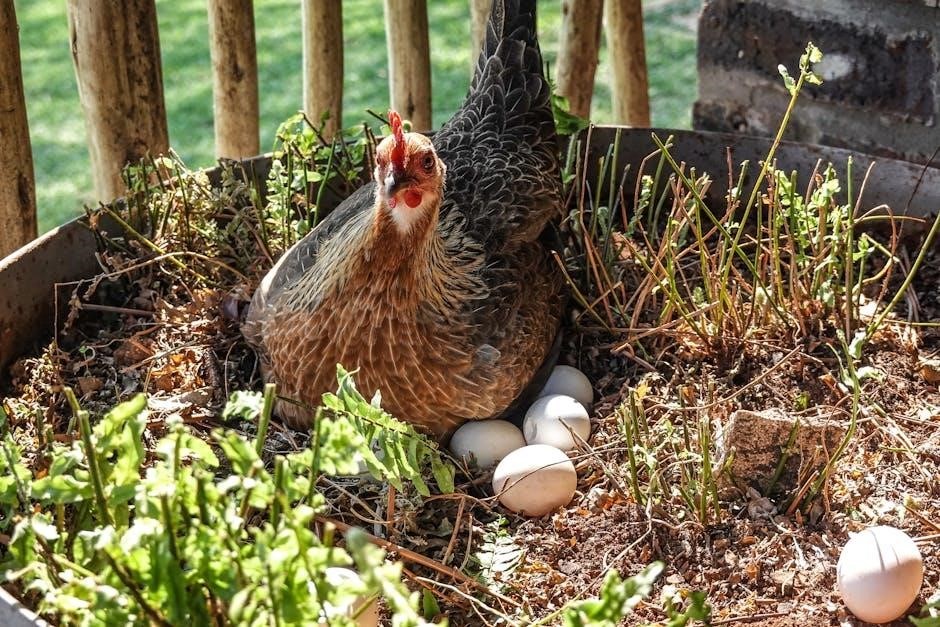Roll away chicken nesting boxes simplify egg collection with their innovative design. This guide provides detailed PDF plans and DIY instructions for building these efficient structures, ensuring clean and easy egg gathering while keeping hens happy and comfortable. Perfect for backyard flocks, these boxes offer a practical solution for poultry keepers.
What is a Roll Away Chicken Nesting Box?
A roll away chicken nesting box is a specialized coop accessory designed to make egg collection easier and cleaner. It features a sloped floor that allows eggs to roll gently into a separate collection area, preventing hens from accessing or damaging them. Built from materials like plywood or solid wood, these boxes are cost-effective and durable. The design typically includes a cubic nesting area with a sloped floor, ensuring eggs roll away smoothly. This system is ideal for backyard flocks, as it reduces egg breakage and keeps the nesting area clean. The roll away mechanism also discourages hens from laying outside the box, making it a practical solution for poultry keepers. With proper construction, these boxes can be easily integrated into any chicken coop setup.
Importance of Nesting Boxes for Chicken Keepers
Nesting boxes are essential for chicken keepers as they provide a safe, comfortable, and clean environment for hens to lay eggs. Without them, hens may lay eggs randomly, leading to broken or soiled eggs and making collection difficult. Roll away nesting boxes, in particular, offer a practical solution by guiding eggs into a separate collection area, reducing contamination and damage. This design also deters hens from accessing laid eggs, minimizing the risk of egg-eating behaviors. Additionally, nesting boxes promote organized flock management and hygienic conditions, ensuring both the health of the hens and the quality of the eggs. They are a vital tool for any poultry keeper aiming to maintain a productive and well-organized chicken coop.

Design Considerations for Roll Away Nesting Boxes
Effective design includes adequate space per hen, a gentle slope for egg rolling, and durable materials like plywood. These features ensure functionality and ease of use.
Space Allocation per Hen
Allocating adequate space per hen is crucial for comfort and productivity. Each nesting area should be approximately 12x12x12 inches, providing enough room for hens to move comfortably. Larger breeds like Brahmas or Buff Orpingtons may require slightly more space to prevent overcrowding. Ensuring sufficient space reduces stress and competition among hens, which can lead to egg-laying issues. Proper allocation also helps maintain cleanliness, as hens are less likely to accidentally soil the nesting area. For small flocks, a single nesting box per 3-4 hens is recommended, while larger flocks may need more boxes to accommodate all birds. This ensures each hen has a clean, private spot to lay eggs.
Slope and Angle for Egg Rolling
The slope and angle of the nesting box floor are critical for smooth egg collection. A gentle incline of 5-8 degrees ensures eggs roll effortlessly to the collection area without breaking; This subtle angle prevents eggs from cracking while allowing hens to comfortably lay without disturbance. The floor should be designed with a smooth surface, such as wooden slats or plastic strips, to guide eggs safely. Properly setting the slope and angle minimizes egg damage and keeps eggs clean, reducing the risk of contamination. This design feature is essential for maintaining egg quality and simplifying the collection process for flock keepers. Ensuring the right slope and angle is a key step in building an effective roll-away nesting box.
Material Selection (Plywood, Solid Wood, etc.)
When building a roll-away nesting box, material selection is crucial for durability and ease of cleaning; Plywood is a popular choice due to its affordability and ease of use, with a single sheet often sufficient for the entire project. Solid wood, such as pine, is another excellent option, offering strength and a natural finish. Both materials are easy to cut and assemble, making them ideal for DIY projects. Metal can also be used for frames, though it is less common for nesting boxes. Ensure all materials are untreated and free from harmful chemicals to protect your flock. Finishing with non-toxic paints or stains can enhance durability and aesthetics. Avoid using materials that may splinter or harm the chickens, as safety and comfort are paramount.

Step-by-Step Guide to Building a Roll Away Nesting Box
Start by cutting plywood for nesting areas, then assemble the box with a sloped floor. Attach the roll-away mechanism and egg collection tray for easy access and cleaning.

Cutting the Plywood for the Nesting Areas
Begin by measuring and cutting plywood according to your nesting box design. Allocate approximately 12x12x12 inches per nesting area for most chicken breeds. Cut the plywood into cubic sections, ensuring smooth edges for comfort. Create a sloped floor with a gentle angle of 5-8 degrees to facilitate easy egg rolling. Attach wooden slats or plastic strips to the floor for a smooth surface. Ensure the nesting areas are spacious enough to accommodate hens comfortably. Properly align and secure the cuts to maintain structural integrity. This step sets the foundation for the roll-away mechanism, making egg collection efficient and hassle-free.
Creating the Roll Away Mechanism
The roll-away mechanism is the heart of this nesting box design. Cut an inclined floor from the back to the front of the nesting area, ensuring a gentle slope of about 5-8 degrees. Attach wooden slats or plastic strips to the floor to create a smooth surface for eggs to roll on. This prevents hens from accessing the eggs, reducing the risk of damage or soiling. Ensure the slope is gentle enough to avoid breaking eggs during the rolling process. Secure the mechanism firmly to the nesting box structure, making sure it is durable and easy to clean. Properly align the eggs’ path to the collection area for efficient gathering. This mechanism simplifies egg collection and keeps eggs clean, making it a crucial feature for any poultry keeper.
Assembling the Nesting Box Structure
Assembling the nesting box structure involves carefully fitting together the pre-cut plywood pieces. Start by constructing the frame, ensuring all edges are smooth to prevent splinters. Attach the walls and roof securely, making sure they are properly aligned and sturdy. Use screws to reinforce the joints for durability. The nesting areas should be cubic, with each measuring approximately 12x12x12 inches, providing ample space for hens to comfortably lay eggs; Ensure the structure is well-ventilated and easy to access for cleaning. Once the main structure is complete, attach the roll-away mechanism and egg collection area. Double-check all connections to ensure stability and functionality. This step is crucial for creating a safe and efficient nesting environment for your chickens.
Attaching the Egg Collection Area
Attaching the egg collection area is a critical step in completing your roll-away nesting box. Ensure the collection trough is securely fastened to the front of the nesting structure using screws or hinges for easy access. The trough should be slightly angled to guide eggs gently into the collection space. Use a soft material, like foam or carpet, at the end of the trough to cushion the eggs as they roll in. Double-check the alignment to prevent eggs from getting stuck or damaged. Once attached, test the mechanism by rolling an egg through to ensure smooth operation. Properly securing the egg collection area ensures easy and efficient egg gathering while maintaining cleanliness and reducing breakage.

Tips for Optimal Egg Collection
Ensure smooth egg collection by maintaining gently sloped floors, preventing hen access to eggs, and keeping the nesting area clean. Regularly inspect and clean the roll-away mechanism to prevent blockages and damage, ensuring eggs roll freely into the collection area. This promotes efficient gathering and reduces the risk of broken eggs, while also maintaining a hygienic environment for your hens.

Ensuring Gently Sloped Floors
A gently sloped floor is crucial for efficient egg collection in roll-away nesting boxes. A slope of 5-8 degrees ensures eggs roll smoothly to the collection area without damage. This design prevents hens from accessing the eggs, reducing breakage and soiling. When building, use plywood or solid wood for the floor and attach wooden slats or plastic strips to create the incline. Ensure the slope is even and free of obstructions to allow eggs to roll effortlessly. Regularly inspect the floor for wear or debris that might disrupt the rolling mechanism. A well-designed slope not only improves egg collection but also keeps the nesting area clean and hygienic, promoting a healthy environment for your hens.
Preventing Hens from Accessing Eggs
Preventing hens from accessing eggs is essential to avoid breakage and soiling. A well-designed roll-away nesting box ensures eggs roll away from the nesting area immediately after laying. Use a secure gap between the nesting box and the egg collection area to prevent hens from reaching the eggs. Consider adding a physical barrier, such as a divider or curtain, to block their view of the collection area. Regularly gathering eggs and maintaining a clean environment also discourages hens from investigating the nesting box. Ensure the slope and roll-away mechanism function smoothly to keep eggs out of reach. These strategies promote efficient egg collection and reduce the risk of egg damage or loss.

Maintaining Cleanliness and Hygiene
Maintaining cleanliness and hygiene in roll-away nesting boxes is crucial for the health of your hens and the quality of eggs. Regularly clean the nesting areas, removing soiled bedding and disinfecting surfaces with pet-safe cleaners. Replace bedding material, such as straw or pine shavings, weekly to absorb waste and reduce odors. The roll-away design allows easy access for cleaning without disturbing the hens. Ensure the egg collection area is free from debris and sanitized to prevent contamination. A clean environment reduces the risk of disease and parasites, keeping your flock healthy. Proper hygiene practices also contribute to higher egg quality and a more pleasant experience for both hens and keepers.

Troubleshooting Common Issues
- Egg damage during rolling? Adjust the slope for gentler movement.
- Hens accessing eggs? Secure gaps between nesting and collection areas.
- Ventilation issues? Ensure proper airflow to prevent moisture buildup.
Addressing Egg Damage During Rolling
Egg damage during rolling can be a common issue in roll-away nesting boxes. To address this, ensure the slope of the nesting area is gentle, ideally between 5-8 degrees. This prevents eggs from bouncing or hitting the collection area too hard. Use smooth materials like plastic strips or rounded edges to guide eggs safely. Additionally, placing soft bedding at the collection point can cushion the eggs. Regularly inspect the roll-away mechanism for any obstructions or uneven surfaces. If damage persists, consider adjusting the slope or adding a dampening material like foam strips. Properly designed systems minimize breakage, ensuring clean and intact eggs for collection. Always test the mechanism with dummy eggs before introducing it to your hens. This step is crucial for refining the design and preventing future issues.

Preventing Hens from Laying Outside the Box
To prevent hens from laying eggs outside the nesting box, ensure the box is secure and properly positioned. Make sure there is enough space between the back of the nest box and the egg collection area to prevent hens from reaching the eggs. Keep the nesting area clean and comfortable, with soft bedding like straw or wood shavings, to encourage hens to lay inside. Train hens by placing them in the nesting box after laying eggs elsewhere. Monitor their behavior and adjust the box design if necessary. Ensuring the nesting box is appealing and accessible will discourage hens from seeking alternative laying spots. Regularly inspect for gaps or weaknesses in the box that hens might exploit. A well-designed roll-away nesting box will keep hens laying where they should, maintaining order and efficiency in egg collection.
Ensuring Proper Ventilation
Proper ventilation is crucial for maintaining a healthy environment in roll-away nesting boxes. Ensure the design includes adequate airflow to prevent moisture buildup and reduce odors. Incorporate small gaps or vents in the structure to allow fresh air to circulate while keeping the interior dry. Positioning the nesting box in a well-ventilated area of the coop can also enhance airflow. Avoid using materials that trap humidity, such as thick plastic, and opt for breathable options like plywood or mesh panels. Regular cleaning and maintaining a slight slope for egg collection can also help prevent moisture accumulation. Proper ventilation not only improves hen health but also ensures eggs remain clean and free from contamination. A well-ventilated nesting box creates a comfortable and hygienic space for laying, benefiting both the hens and the keeper. This ensures a fresh and healthy environment for egg production.

Additional Resources and Plans
Explore detailed PDF plans and YouTube tutorials for roll-away nesting boxes. Access SketchUp models and cut lists for precise construction. These resources offer visual guidance and customization tips for your project.
Recommended PDF Plans for Roll Away Nesting Boxes
For a seamless DIY experience, consider downloading detailed PDF plans for roll-away nesting boxes. These plans often include a materials list, step-by-step instructions, and precise measurements to ensure your project is a success. Many PDF guides are designed for beginners, offering clear visuals and easy-to-follow directions. For example, a popular plan uses a single sheet of plywood to construct a nesting box with multiple compartments, costing around $40 in materials. Another option is a comprehensive guide from HGTV, which includes a bump-out design for easy egg access. These plans also highlight important features like sloped floors and egg collection areas. By using a PDF plan, you can save time and ensure your roll-away nesting box is both functional and durable, providing a clean and efficient space for your hens to lay eggs.
YouTube Tutorials for Visual Guidance
YouTube offers an array of detailed tutorials to guide you through building roll-away nesting boxes. These videos provide step-by-step visual instructions, making the process easier for DIY enthusiasts. Many tutorials focus on transforming a single sheet of plywood into a functional nesting box, complete with a roll-away mechanism. They often include tips on materials, precise measurements, and assembly techniques. For example, one popular video demonstrates how to create a nesting box with a sloped floor and egg collection area in under 90 minutes. Others share insights on preventing egg damage and ensuring proper ventilation. These tutorials are particularly helpful for beginners, offering a clear visual understanding of the build process and helping you avoid common pitfalls. They complement PDF plans by providing real-time guidance, making your project more manageable and enjoyable.
SketchUp Models for Detailed Design
SketchUp models provide a comprehensive 3D visualization of roll-away nesting box designs, allowing users to explore every detail before construction. These models are particularly useful for understanding the layout, measurements, and assembly process. Many creators offer customizable SketchUp files, enabling users to adjust dimensions and features to suit their specific needs. The models highlight key components, such as the nesting areas, sloped floors, and egg collection systems. By examining these designs, builders can better plan their projects and ensure accuracy. Additionally, SketchUp models complement PDF plans and video tutorials, offering a deeper understanding of the structure. They are especially helpful for visual learners who prefer to see the design in 3D before starting their build. This resource is invaluable for achieving precise and professional results.
Roll away nesting boxes offer efficient egg collection and durability, benefiting both hens and keepers. Use these plans and tips for a successful and organized setup.
Benefits of Roll Away Nesting Boxes
Roll away nesting boxes offer numerous advantages for chicken keepers. They simplify egg collection, reduce egg damage, and prevent hens from accessing laid eggs, minimizing breakage. The sloped design ensures eggs roll gently into a collection area, keeping them clean and intact. These boxes also save space, as they can be compactly designed while still providing comfort for hens. Additionally, roll away nesting boxes promote hygiene by separating eggs from nesting material, reducing the risk of contamination. Their durable construction from materials like plywood or solid wood ensures longevity. Overall, they improve efficiency, reduce labor, and enhance the overall egg-laying experience for both hens and keepers, making them a practical and beneficial addition to any chicken coop.
Final Tips for Successful Implementation
For a successful roll away nesting box setup, ensure the slope is gentle to prevent egg damage and keep the collection area clean. Provide adequate space per hen, typically 12×12 inches, to avoid overcrowding. Use durable materials like plywood or solid wood for longevity. Regularly clean the nesting areas to maintain hygiene and prevent pests. Train hens to use the boxes by placing them in the coop at a comfortable height. Consider adding bedding like straw for comfort. Ensure the egg collection area is secure to prevent hens from accessing eggs. Finally, monitor the system to address any issues promptly, such as hens laying outside the box or eggs not rolling smoothly. Proper implementation enhances egg collection efficiency and hen comfort.